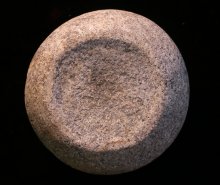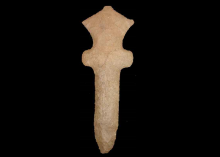On the Eve of European Exploration (600-300 years ago; 1400-1700)
The Cahokian way of life declined and then disappeared about 550 years ago. A different way of life emerged that included immigrant groups from other regions. Tribal groups hunted and gathered natural resources and cultivated maize, but their communities were smaller, their economy not as far-reaching, and their social organization was less complex. By 350 years ago, some tribes, such as the Kaskaskia, relocated to Illinois as European settlement on the east coast expanded.
After thousands of years of using stone, and to a lesser extent mussel shell digging tools, some Native people transformed the bison’s shoulder blade, or scapula, into digging tools to tend their gardens.
In the 1720s, Le Page du Pratz visited a Natchez village near New Orleans and observed men playing games with a disc-shaped stone. In one game, a man rolled a stone across the ground. When the stone came to rest, other men wagered on who could cast a spear closest to the stone. Du Pratz published his account of the game and other aspects of Natchez life in a book titled The History of Louisiana.
This specimen of the Ivory-billed Woodpecker (Campephilus principalis) (here compared with the common Pileated Woodpecker on the left) is not from Illinois. The only Illinois records we have are observations from naturalists, mostly in the 1800s. John James Audubon, the famous bird artist, encountered calling Ivory-billed Woodpeckers in the 1820s on both sides of the Ohio River where it meets the Mississippi River at Cairo. Southern Illinois was the far northern extent of the species at that time.










